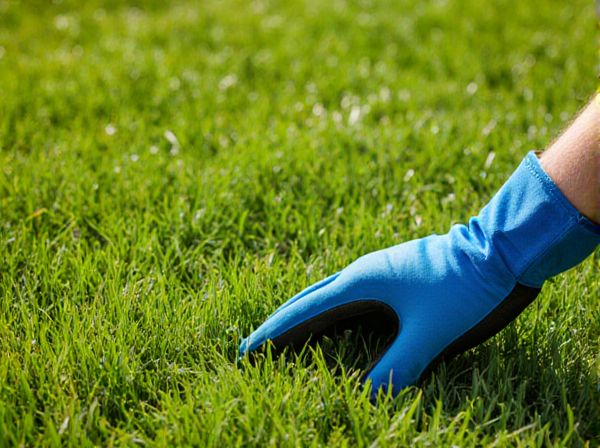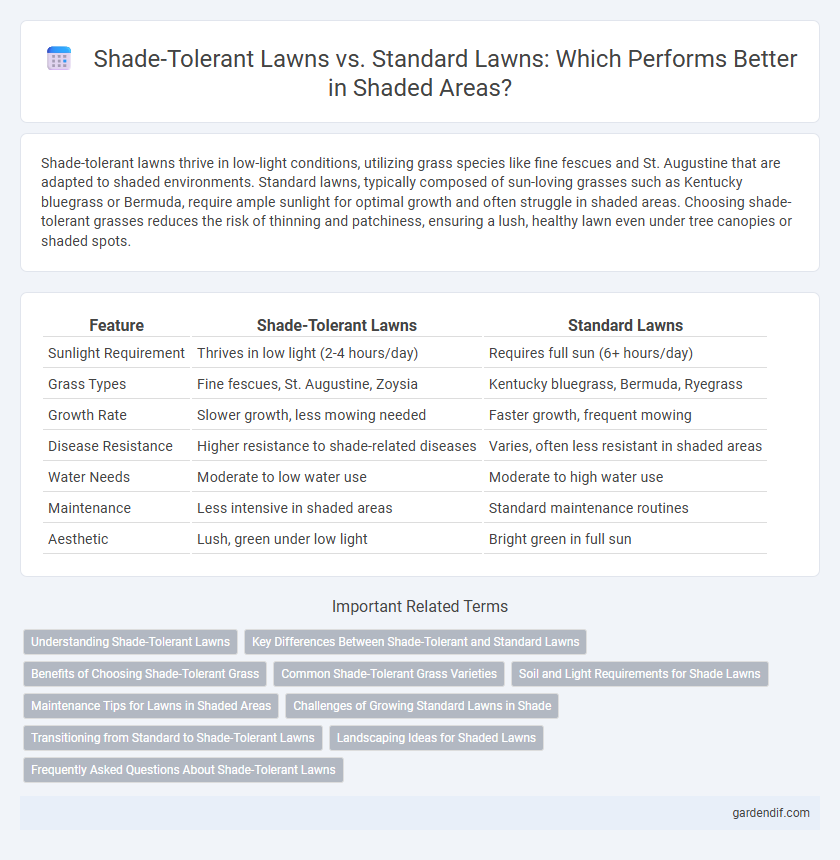
Shade-Tolerant Lawns vs Standard Lawns Illustration
Shade-tolerant lawns thrive in low-light conditions, utilizing grass species like fine fescues and St. Augustine that are adapted to shaded environments. Standard lawns, typically composed of sun-loving grasses such as Kentucky bluegrass or Bermuda, require ample sunlight for optimal growth and often struggle in shaded areas. Choosing shade-tolerant grasses reduces the risk of thinning and patchiness, ensuring a lush, healthy lawn even under tree canopies or shaded spots.
Table of Comparison
| Feature | Shade-Tolerant Lawns | Standard Lawns |
|---|---|---|
| Sunlight Requirement | Thrives in low light (2-4 hours/day) | Requires full sun (6+ hours/day) |
| Grass Types | Fine fescues, St. Augustine, Zoysia | Kentucky bluegrass, Bermuda, Ryegrass |
| Growth Rate | Slower growth, less mowing needed | Faster growth, frequent mowing |
| Disease Resistance | Higher resistance to shade-related diseases | Varies, often less resistant in shaded areas |
| Water Needs | Moderate to low water use | Moderate to high water use |
| Maintenance | Less intensive in shaded areas | Standard maintenance routines |
| Aesthetic | Lush, green under low light | Bright green in full sun |
Understanding Shade-Tolerant Lawns
Shade-tolerant lawns thrive in low-light environments by utilizing grass species such as fine fescues and St. Augustine grass, which adapt to limited sunlight better than standard turf varieties. These grasses maintain healthy growth by developing broader leaves and shallower root systems to maximize light absorption and moisture retention under shaded canopies. Understanding the specific shade tolerance of different grass species allows for more effective lawn care, reducing thinning and patchiness common in standard lawns exposed to shade.
Key Differences Between Shade-Tolerant and Standard Lawns
Shade-tolerant lawns thrive under low light conditions by utilizing grass varieties like fine fescues and St. Augustine, which have adapted to photosynthesize efficiently in shade. Standard lawns, often composed of Kentucky bluegrass or Bermuda grass, require full sunlight for optimal growth and may develop thin, patchy areas in shaded environments. The primary differences lie in sunlight requirements, grass species selection, and maintenance practices tailored to ensure healthy turf in shaded versus sun-exposed landscapes.
Benefits of Choosing Shade-Tolerant Grass
Shade-tolerant grass varieties such as fine fescues and St. Augustine grass are specifically adapted to thrive in low-light conditions, maintaining vibrant color and density where standard lawn grasses often thin out or die. These grasses provide enhanced disease resistance and reduced water requirements compared to traditional turf, resulting in a more sustainable and low-maintenance lawn solution for shaded areas. By selecting shade-tolerant lawns, homeowners achieve lush greenery under trees or shaded patios, improving aesthetic appeal and environmental resilience without the need for excessive fertilization or irrigation.
Common Shade-Tolerant Grass Varieties
Common shade-tolerant grass varieties include Fine Fescue, St. Augustinegrass, Zoysia, and Tall Fescue, each offering unique adaptations to low-light environments. Fine Fescue thrives in cool-season climates with excellent shade tolerance, while St. Augustinegrass is a warm-season grass favored in southern regions for its dense growth in shaded areas. Zoysia and Tall Fescue provide durable options that resist wear and maintain green color under moderate shade, making them optimal choices for lawns receiving limited sunlight.
Soil and Light Requirements for Shade Lawns
Shade-tolerant lawns require well-drained, nutrient-rich soil with higher organic matter to support grass varieties like fine fescues that thrive in low-light conditions. These lawns perform best under filtered sunlight or partial shade of 2 to 4 hours daily, unlike standard lawns needing full sun exposure for at least 6 hours. Soil moisture retention is crucial in shady areas to maintain turf health, as reduced light slows photosynthesis and water uptake.
Maintenance Tips for Lawns in Shaded Areas
Shade-tolerant lawns require less frequent watering and mowing compared to standard lawns due to slower growth rates under low light conditions. Applying a light layer of organic mulch helps improve soil moisture retention and nutrient availability for grass species like fescue and fine-bladed ryegrass. Regular aeration and targeted fertilization with balanced nitrogen-phosphorus-potassium (NPK) fertilizers support root health and enhance turf density in shaded environments.
Challenges of Growing Standard Lawns in Shade
Growing standard lawns in shaded areas presents challenges such as reduced photosynthesis due to limited sunlight, resulting in weak, thin grass blades and increased susceptibility to pests and diseases. These lawns often experience uneven growth and patchiness because standard grass varieties require more direct sunlight to thrive. Shade-tolerant lawns incorporate specialized grass species that adapt better to low-light conditions, promoting healthier, denser turf in shaded environments.
Transitioning from Standard to Shade-Tolerant Lawns
Transitioning from standard lawns to shade-tolerant lawns involves selecting grass species like fine fescues, St. Augustine, or Zoysia that thrive in low-light conditions. Proper soil preparation, including aeration and organic matter addition, enhances root development and nutrient uptake in shaded environments. Adjusting mowing height and irrigation practices helps maintain turf health and density, ensuring a gradual and sustainable lawn transformation.
Landscaping Ideas for Shaded Lawns
Shade-tolerant lawns thrive under trees and in low-light areas by using grass species like fine fescue, St. Augustine, or Zoysia that require less direct sunlight than standard lawns. Landscaping ideas for shaded lawns include incorporating mulch beds, shade-loving ground covers like hostas or ferns, and creating layered plantings to enhance soil moisture and reduce erosion. Selecting appropriate grass varieties and integrating complementary plants improves lawn health and aesthetic appeal in consistently shaded environments.
Frequently Asked Questions About Shade-Tolerant Lawns
Shade-tolerant lawns thrive in low-light environments by utilizing grass species like fine fescues, St. Augustine grass, and Zoysia, which have adaptations for reduced sunlight. These lawns require less frequent mowing and watering compared to standard lawns, making them ideal for shaded areas under trees or near buildings. Proper soil aeration and fertilization help maintain their health and resilience despite limited sun exposure.
Shade-Tolerant Lawns vs Standard Lawns Infographic

 gardendif.com
gardendif.com